The grass plant
Grass flowers
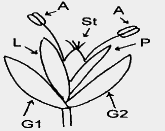
Florets. A floret has two husks. The lower is the lemma and the upper the palea. Between the lemma and the palea there is the ovule (the seed), which is topped by the stigma. There are also one or more anthers on slender stalks (the stamens).
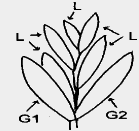
Spikelets with many florets. A spikelet may have one or more florets. The spikelet (right) has five florets. Only the lemmas can be seen. The paleas are tucked inside the lemmas.
One or more husks may be absent. A floret without an ovule or anthers is said to be infertile or barren.
Fertilization occurs when pollen, produced by an anther, attaches to the sticky stigma tips. The pollen is carried by wind.
Flower arrangements and florets.
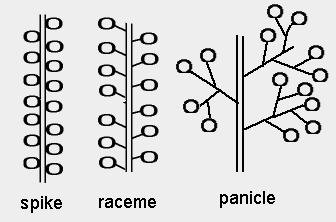
A spike has stalkless flowers. The spikelets are often nestled into hollows in the stem e.g. Rye Grass.
A raceme has stalked flowers. The unbranched flower stalks are attached directly to the main stalk.
Panicles have branched flower stalks. Panicles are by far the most common arrangement. The flower cluster may be open, with the branches well separated; or condensed or narrow, where the branches remain close to the main stalk; or condensed and spike-like, where the flowers are crowded into a dense mass and the flower stalks are hidden.
Inside a floret.
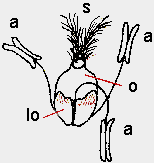
The anthers (a)are the male part of the flower and produce pollen.
The ovule contains the developing seed. The stigmas (s) have sticky tips to catch the wind-blown pollen. The lodicules are thought to be reduced petals. They swell to open the husks to allow for fertilisation. After fertilisation they contract.
Ligules and nodes
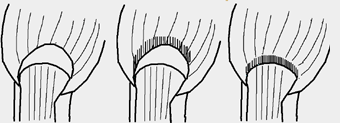
The lower part of the leaf is the sheath, and is wrapped around the stalk. The sheath is not usually joined into a complete cylinder. The ligule is at the place leaf blade spreads away from the stalk. The ligule may be a membrane (left), a fringed membrane(middle) or a row of hairs (right).
A membranous ligule may be pointed, rounded or cut of squarely i.e. truncate.
The leaf blade may be flat, folded into a V, or curled (rolled or inrolled) into a narrow cylinder. Leaves often fold or curl as they dry.

The stalks usually have one or more joints along the stalk. These are called nodes. The nodes are often darker in colour, and may be smooth or hairy.
C3 and C4 grasses
There are two different ways that grasses can convert carbon dioxide into sugars and starch (i.e. two different photosynthetic methods). These are called C3 and C4, because of the different lengths of carbon chains in an intermediate stage. C3 grasses are cold weather grasses and C4 grasses grow more strongly in hot weather.
Annual and perennial grasses
Annual grasses complete their lifecycle, from seed to death, within a year. Perennial grasses are long lived. A simple test for established grasses is to attempt pull them out. Annuals are usually easily pulled, perennials are more difficult or impossible. This method is only suitable for weed species.